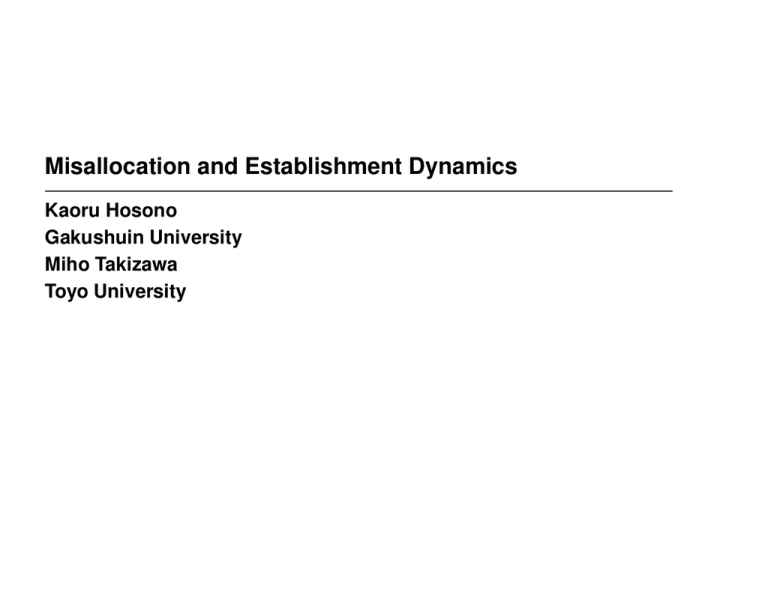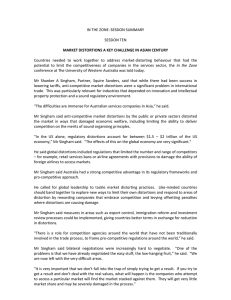Misallocation and Establishment Dynamics Kaoru Hosono Gakushuin University Miho Takizawa
advertisement

Misallocation and Establishment Dynamics
Kaoru Hosono
Gakushuin University
Miho Takizawa
Toyo University
Motivation
Regulations and other market frictions cause a gap between marginal revenues and marginal costs (distortions or wedges), which potentially lowers
aggregate productivity through inefficient
1. allocation of resources (Hsieh and Klenow, 2009; Restuccia and Rogerson, 2008)
2. technology choice (Midrigan and Xu, 2012)
3. entry and exit (Restuccial and Rogerson, 2008)
To what extent?
2
Aim
• To offer new evidence on the effects of establishment-level distortions
on
(1) aggregate productivity
(2) size distribution
(3) establishment-level productivity growth
(4) entry/exit
• To explore the factors that affect establishment-level distortions
3
What we do
1. Using establishment-level data from Japanese manufacturers, we measure establishment-level distortions following Hsieh and Klenow (2009).
2. Using measured establishment-level distortions, we calculate the hypothetical aggregate TFP and hypothetical size distribution that would
be realized without distortions.
3. We estimate the effects of distortions on establishment entry and exit
and on subsequent establishment-level productivity growth.
4. We regress distortions on proxies for regulations, external finance constraints, and labor market frictions.
4
What we find
1. If capital and labor were reallocated in Japanese manufacturing industries to equalize marginal products to the extent observed in the
U.S. manufacturing industries, aggregate total factor productivity (TFP)
would rise by 6.2%.
2. The efficient establishment size distribution would be more dispersed
than the actual one.
3. Distortions have significant impacts on entry and exit, and establishmentlevel productivity growth.
4. Financial frictions is a source for capital distortions.
5
Related Literature
• Literature on the effects of distortions on aggregate productivity (Hsieh
and Klenow, 2009; Restuccia and Rogerson, 2008; Bartelsman et al.,
2013)
• Literature on the misallocation of credit in the 1990s’s Japan (Caballero et al., 2008)
6
Composition
1. Introduction
2. Measurement of Distortions and Their Effects on Aggregate TFP, PlantSize Distribution, Entry/Exit, and Establishment-level Productivity Growth
3. Factors for Establishment-level Distortions
4. Conclusion
7
Composition
1. Introduction
2. Measurement of Distortions and Their Effects on Aggregate TFP,
Plant-Size Distribution, Entry/Exit, and Establishment-level Productivity Growth
3. Factors for Establishment-level Distortions
4. Conclusion
8
How to measure distortions: Intuition
If allocation is efficient, MPK is equalized at rental cost.
9
How to measure distortions: Intuition
If allocation is inefficient, MPK differs across establishments, resulting in
lower aggregate production and productivity.
10
How to measure distortions: Intuition
Distortion is caused not only by taxes and subsidies but also by regulations
and market frictions.
11
How to measure distortions
We allow for market power (monopolistic competition) and for two sorts of
distortions (capital and output, or equivalently, capital and labor)
12
Measurement
We follow Hsieh and Klenow (2009). A static, partial-equilibrium, monopolistic competition model with exogenous output and capital distortions.
There are a final good producer, representative industrial good producers,
one for each industry, and many differentiated good producers.
13
Measurement: Final good and industrial good producers
The final good producer combines the output Ys of industry s ∈ {1, ..., S}
and produces Y using a Cobb-Douglas production technology,
Y =
S
∏
Ysθs , where
s=1
S
∑
θs = 1.
s=1
Industry good producer s combines differentiated good si ∈ {1, ..., Ms} to
produce industry output Ys using a CES production technology,
Ys =
Ms
∑
σs
σs −1 σs −1
σs
Ysi
,
σs > 1
i=1
1
σs
Y
The price elasticity of demand for differentiated good is σs: Psi = PsYs
14
− σ1s
si
Measurement: Differentiated Good Producers
Producer si produces a differentiated good Ysi from capital Ksi and labor
Lsi using a constant returns to scale Cobb-Douglas production technology
with idiosyncratic TFP, Asi,
αs 1−αs
Ysi = AsiKsi
Lsi
Producer si faces idiosyncratic output and capital distortions, τY si and
τKsi, and maximizes his profits:
Πsi = (1 − τY si)PsiYsi − wLsi − (1 + τKsi)RKsi
15
Measurement: Why Not Distortions on Labor?
We can identify only two of output, labor, and capital distortions from the
FOCs.
∗ and capSuppose alternatively that producer si faces labor distortion τLsi
∗ . Our measures can be interpreted as being ”standardital distortion τKsi
ized” by one plus labor distortion.
1
1 − τY si = 1+τ
∗
Lsi
∗
1+τKsi
1 + τKsi = 1+τ ∗ .
Lsi
Which specification we choose does not affect our measures of aggregate
TFP efficiency (TFPGAIN or TFPGAP) or the plant-size distributions that
would be realized if we removed distortions.
16
Measurement: Measuring Producer-Level Distortions and
Productivity
From producer si’s optimal decision and demand function, we obtain
αs wLsi
1 + τKsi =
1 − αs RKsi
σs
wLsi
1 − τY si =
σs − 1 (1 − αs)PsiYsi
Asi = κs
(PsiYsi
σs
σ
) s−1
αs 1−αs
Ksi
Lsi
,
We can retrieve τKsi, τY si and Asi from observable data given R and σ.
We call Asi “physical productivity” or “TFPQ” and distinguish it from the
“revenue-based productivity” or “TFPR” (≡ PsiAsi) .
(
σ
T F P Rsi =
σ−1
)(
) (
)1−αs
R αs
w
(1 + τKsi)αs
.
αs
1 − αs
1 − τY si
17
Measurement: Aggregate TFP
Once we have measured producer-level distortions and TFPQ, it is straightforward to derive aggregate TFP.
Without distortions, revenue-based productivity (TFPR) would be equalized across producers even though physical productivity (TFPQ) differs: a
more productive producer operates at a larger scale and sells its product
at a lower price.
To the extent that revenue-based productivity differs across producers, aggregate TFP is lower than the efficient aggregate TFP, which would be
achieved without any distortions.
Aggregate TFP depends on the deviation of T F P Rsi from its industry average for each industry.
18
Measurement: Aggregate TFP: Definitions
Efficient aggregate TFP=Hypothetical aggregate TFP that would be realized without capital or output distortions.
T F P GAP =Actual aggregate TFP/Efficient aggregate TFP.
T F P GAIN =1/TFPGAP-1.
Since we will analyze borrowing constraints that result in capital distortions,
we also define the followings:
T F P GAPcapital =Actual aggregate TFP/Hypothetical aggregate TFP that
would be realized without output distortions only.
T F P GAINcapital =1/T F P GAPcapital -1.
19
Measurement: Aggregate TFP: Definitions
Efficient TFP
Output distortions
(Output distortions=0)
TFPGAP
Capital distortions
TFPGAPcapital
Capital distortions
Actual TFP
20
Measurement: Notes on TFPGAP
1. TFP gap is an efficiency measure given the market structure of monopolistic competition (i.e., given σs).
2. TFP gap measures the allocation efficiency and as such reflects the
variation in, not the average of, distortions across producers,in contrast with ”business cycle accounting” (e.g., Chari et al., 2007).
3. TFP gap is a measure of allocation efficiency given total resources.
21
Measurement: Size Distribution
Distortions affect the size distribution, since
log(Ysi) = σslog(1 − τY si) − αsσslog(1 + τKsi) + σslog(Asi) + const,
log(Ysi) tends to be more dispersed
• if either type of distortions are more dispersed,
• if either type of distortions are less positively (or more negatively) correlated with TFPQ, or
• if the two distortions are more positively (or less negatively) correlated
with each other.
22
Measurement: Data
We use the plant-level data underlying the Census of Manufacturing that
spans from 1981 to 2008.
Coverage: All establishments falling into manufacturing industries and located in Japan. We restrict our sample firms to those with tangible fixed
asset data: plants with 10 or more employees for 1981-2000 and 2005, 30
or more employees for 2001-04 and 2006-08.
Labor quality: We adjust the quality of workers and hours worked assuming
that they are reflected by plant-level annual, per-worker wage relative to its
industry average.
Parameters: We set R = 0.1. We set σs based on Broda and Weinstein (2006) as a baseline. (4.8, 3.4, and 2.5 for 1981-1989 and 3.5, 2.9,
and 2.1 for 1990-2008 for commodity, reference-priced, and differentiated
goods, respectively) as a baseline case. Alternatively, we also setσ = 3 to
compare with Hseih and Klenow (2009).
23
Measurement: Data
Outliers: We trim the 1% tails of marginal revenue of capital, marginal
revenue of labor, and TFPQ, all standardized by industry average.
Number of total plant-year observations: 3,565,341.
24
0
.05
Density
.1
.15
.2
Measurement: Distribution of log(Asi)
0
5
10
15
20
25
log(Asi)
25
0
0
.1
.2
Density
Density
.2
.4
.3
.6
Measurement: Distribution of log(1 − τY si) and log(1 +
τKsi)
-15
-10
log(1- τY )
-5
0
-15
-10
-5
0
log(1+τK)
5
10
26
Measurement: TFPGAP and TFPGAIN
Elasticity of substitution
Output distortions and capital distortions=0
T F P GAP
T F P GAIN
Output distortions=0
T F P GAPcapital
T F P GAINcapital
Japan
Baseline
United States
σ=3
0.717
39.6%
0.690
44.9%
0.733
36.60%
0.826
21.1%
0.821
21.7%
N.A.
N.A.
If capital and labor were reallocated in Japan to equalize marginal products to the extent observed in the US, manufacturing TFP in Japan would
increase by 6.2%.
Capital distortions account for about half of the total TFPGAIN.
27
Measurement: TFPGAIN and TFPGAP
Japan’s allocation efficiency is worse than that of the U.S., and much better
than China and India, which would increase aggregate TFP by 30-50% and
40-60%, respectively, if their resources were reallocated to the efficiency
level of the US (Hsieh and Klenow, 2009).
To examine whether our result for Japan’s TFPGAIN is plausible, we use
the country ranking on ease of doing business, provided in World Bank
(2012), although far from an accuracy proxy for allocation efficiency: The
United States, Japan, China, and India rank in 4th, 20th, 91th, and 132th
place, respectively.
28
Measurement: Actual and Efficient Size Distributions
0
.05
.1
.15
Removing both distortions would make the size distribution more dispersed.
0
10
Actual log(Y)
20
30
40
Hypothetical log(Y) without output or capital distortions
Density of Actual log(Ysi ) (Blue Line) and the Hypothetical log(Ysi ) for τY si = τKsi = 0 (Red Line).
29
Measurement: Actual and Efficient Size Distributions
0
.05
.1
.15
Removing only output distortions would make the size distribution more
concentrated.
0
10
Actual log(Y)
20
30
40
Hypothetical log(Y) without output distortions
Density of Actual log(Ysi ) (Blue Line) and the Hypothetical log(Ysi ) for τY si = 0 (Red Line).
30
Measurement: Distribution of output: Actual and Hypothetical in the Case of No Distortions
Without distortions, the largest establishments (top 0.01% to top 20%)
should have a larger share, while the smallest establishments (bottom
20%) should have a smaller share.
(1)
Actual output
Interquartile range
25th percentile
75th percentile
3.935
15.266
19.201
(2)
τY si = 0
τKsi = 0
4.024
15.173
19.198
(3)
τY si = 0
Output share of largest 0.01% of establishments
Output share of largest 0.1% of establishments
Output share of largest 1% of establishments
Output share of largest 5% of establishments
Output share of largest 10% of establishments
Output share of largest 20% of establishments
39.13%
76.17%
95.38%
99.03%
99.59%
99.86%
58.93%
86.86%
97.93%
99.62%
99.84%
99.95%
47.16%
81.38%
96.63%
99.31%
99.71%
99.90%
Output share of smallest 1% of establishments
Output share of smallest 5% of establishments
Output share of smallest 10% of establishments
Output share of smallest 20% of establishments
0.00000%
0.00003%
0.00014%
0.00075%
0.00000%
0.00001%
0.00004%
0.00024%
0.00000%
0.00003%
0.00012%
0.00058%
3.871
15.333
19.204
31
Measurement: Robustness: Subperiods
Allocation efficiency tended to worsen during the past three decades.
1981-2008
(Baseline)
1981-89
1990-99
2000-08
Actual size distribution
Interquartile range
Output share of largest 1% of establishments
Output share of smallest 20% of establishments
3.935
95.38%
0.001%
2.635
79.66%
0.04%
2.992
92.26%
0.004%
3.586
90.36%
0.002%
Output distortions and capital distortions=0
T F P GAP
T F P GAIN
Interquartile range
Output share of largest 1% of establishments
Output share of smallest 20% of establishments
0.717
39.56%
4.024
97.93%
0.000%
0.733
36.42%
3.009
82.97%
0.017%
0.716
39.67%
3.316
94.03%
0.002%
0.701
42.71%
3.919
95.73%
0.000%
Output distortions=0
T F P GAPcapital
T F P GAINcapital
Interquartile range
Output share of largest 1% of establishments
Output share of smallest 20% of establishments
0.826
21.05%
3.871
96.63%
0.001%
0.838
19.32%
2.586
79.73%
0.040%
0.832
20.25%
2.970
93.22%
0.004%
0.808
23.77%
3.609
92.66%
0.001%
32
Measurement: Robustness: Subperiods
Allocation efficiency tended to worsen during the past three decades.
0.9
0.85
0.8
0.75
TFPGAP
TFPGAPcapial
0.7
0.65
0.6
1
8
9
1
2
8
9
1
3
8
9
1
4
8
9
1
5
8
9
1
6
8
9
1
7
8
9
1
8
8
9
1
9
8
9
1
0
9
9
1
1
9
9
1
2
9
9
1
3
9
9
1
4
9
9
1
5
9
9
1
6
9
9
1
7
9
9
1
8
9
9
1
9
9
9
1
0
0
0
2
1
0
0
2
2
0
0
2
3
0
0
2
4
0
0
2
5
0
0
2
6
0
0
2
7
0
0
2
8
0
0
2
T F P GAP (τY si = τKsi = 0) and T F P GAPcapital (τY si = 0).
33
Measurement:Robustness
Actual size distribution
Interquartile range
Output share of largest 1% plants
Output share of smallest 20% plants
Output distortions and capital distortions=0
TFPGAP
TFPGAIN
Interquartile range
Output share of largest 1 % plants
Output share of smallest 20 % plants
Output distortions=0
TFPGAPcapital
TFPGAINcapital
Interquartile range
Output share of largest 1 % plants
Output share of smallest 20 % plants
(1)
Baseline
(2)
1981-2000
and 2005
(3)
Trimming ±2%
3.935
95.38%
0.001%
3.640
95.40%
0.001%
3.887
94.14%
0.001%
0.717
39.56%
4.024
97.93%
0.0002%
0.722
38.49%
3.751
97.14%
0.001%
0.760
31.63%
3.944
97.09%
0.000%
0.826
21.05%
3.871
96.63%
0.0006%
0.832
20.16%
3.565
96.25%
0.001%
0.866
15.48%
3.825
95.52%
0.001%
34
Entry and Exit
Distortions may either
• promote exit by lowering profitability, or
• hinder entry/exit by giving incumbents higher rents.
35
Exit
We estimate
P rob(Exitsit = 1)
T F P Qsit−1
= β1T F P Rst−1 + β2
T F Pst−1
+ β3log(1 − τY sit−1) + β4log(1 + τKsit−1)
+ β5log(agesit−1) + yeardummyt + industrydummys + ϵsit,
where T F P Rs denotes the industry average of both types of distortions.
36
Probit Estimation of Exit Probability
A higher industry-level average of distortions (T F P Rs) lowers exit probability, while higher establishment-level distortions within an industry heighten
exit probability.
T F P Rs
T F P Qsi/T F P Qs
log(1 − τY si)
log(1 + τKsi)
log(age)
(log(age))2
(log(age))3
(log(age))4
constant
year dummy
industry dummy
Number of Obs.
Pseudo R-squared
Marginal Effect
-0.017
-0.027
-0.023
0.013
-0.020
-0.006
0.003
0.000
Robust Std. Err.
0.004***
0.003***
0.005***
0.001***
0.004***
0.006
0.003
0.001
Yes
Yes
2612536
0.079
37
Entry
Entryst = β1T F P Rst + industrys + yeart + ϵst,
Random-effect Model
Coef.
Std. Err.
T F P Rst
-0.0001 0.00003***
Constant
0.2039 0.01475***
Year dummy
Yes
Industry dummy
Yes
Number of obs.
1001
R-squared within
0.4104
R-squared between 1
R-squared overall
0.5252
A higher industry average of distortions lowers the entry rate.
38
Establishment-level Productivity Growth
Distortions may affect establishment-level productivity growth (GT F P Q).
For example, Midrigan and Xu (2012) posit that financial frictions affect
technology adoption and thus productivity.
T F P Qsi0
+ β2log(1 − τY si0)
T F P Qs0
+β3log(1 + τKsi0) + year0 + industrys + ϵit,
GT F P Qsi = β0 + β1
where GT F P Qsi is the average growth rate of establishment i over the
years after entrance.The subscript 0 denotes the year when the establishment enters the market.
39
Establishment-level Productivity Growth
Establishment-level distortions have negative impacts on productivity growth
subsequent to entry.
Period
T F P Qsi /T F P Qs
log(1 − τY si )
log(1 + τKsi )
Constant
Year dummy
Industry dummy
Number of obs.
F( 81,328901)
Prob > F
R-squared
Adj. R-squared
Root MSE
1981-2008
Coeff.
-0.032
0.088
-0.032
-0.027
yes
yes
328983
519.08
0
0.1133
0.1131
0.40441
Std. Err.
0.001
0.002
0.001
0.008
***
***
***
***
1981-2000
Coeff.
-0.027
0.093
-0.035
-0.017
yes
yes
Std. Err.
0.001
0.002
0.001
0.008
***
***
***
**
316293
541.88
0
0.1112
0.111
0.4042
40
Sources of Distortions
A number of preceding studies focus on financial frictions as a source of
distortions (Jeong and Townsend,2007; Amaral and Quintin, 2010; Buera
et al., 2011; Moll 2010; Midrigan and Xu, 2012; Gilchrst et al., 2012; Greenwoowd et al, 2012; Pratap and Urrutia, 2012).
If the supply of external finance is limited due to informational or contractual
frictions, then establishments that are more dependent on external finance
are likely to be subject to greater distortions.
Following Rajan and Zingales (1998), we measure external finance dependence as the difference between capital expenditures and cash flow from
operations divided by capital expenditures.
We use the industry-level median of external finance dependence using a
dataset of Japanese listed firms over the period of 1981-2007.
41
Sources of Distortions
Distortionsit = βF ins + γXsit + αY eart + ϵsit,
(1+τKsit )αs
where Distortionsit, is either T F P RGAPsit ≡
1−τY sit , τY sit, or
τKsit, F ins is our measure of external finance dependence, and Xsit is
a vector of establishment- and industry-specific control variables.
42
External finance dependence
T F P RGAPsit
0.772
(0.226)***
τY sit
1.071
(0.362)***
τKsit
1.238
(0.688)*
0.168
(0.043)***
0.212
(0.135)
0.041
(0.016)**
-0.104
(0.037)***
0.004
(0.054)
-0.257
(0.058)***
14.312
(4.687)***
12.624
(5.188)**
13.657
(4.860)***
16.247
(4.988)***
14.117
(4.849)***
-0.143
(0.499)
-14.398
(4.592)***
0.398
(0.097)***
0.297
(0.282)
0.091
(0.036)**
-0.199
(0.084)**
-0.204
(0.123)
-1.099
(0.157)***
22.725
(9.318)**
22.558
(9.985)**
21.014
(9.551)**
29.214
(9.826)***
25.701
(9.470)***
-0.474
(0.947)
-27.448
(8.815)***
-0.222
(0.075)***
-0.007
(0.376)
-0.141
(0.063)**
-0.413
(0.095)***
0.773
(0.167)***
2.086
(0.255)***
-12.288
(19.020)
-19.893
(14.391)
-6.484
(16.887)
-28.894
(15.528)*
-16.444
(16.660)
2.331
(1.914)
20.008
(15.322)
Log (age)
Log(T F P Qsi)
Regulation index
Export dummy
Log(number of employees)
Corporation dummy
Sole proprietorship dummy
Share of workers aged 20-29
Share of workers aged 30-39
Share of workers aged 40-49
Share of workers aged 50-59
Share of workers aged 60+
Share of part-time workers
Constant
τKsit
1.252
(0.689)*
-0.181
(0.026)***
-0.219
(0.074)***
-0.005
(0.377)
-0.141
(0.064)**
-0.395
(0.095)***
0.768
(0.166)***
2.068
(0.253)***
-12.095
(18.972)
-19.587
(14.383)
-6.388
(16.848)
-28.445
(15.503)*
-16.157
(16.626)
2.276
(1.910)
19.68543
(15.297)
Sources of Distortions: Results
• External finance dependence takes a positive and marginally significant coefficient in all the regressions.
• Firm age takes a negative and significant coefficient in the regression
of τKsit, suggesting financial constraints.
• Log(TFPQ) and export dummy take a positive and significant coefficient in the regressions of T F P RGAPsit and τY sit, while they take a
negative and significant coefficient in the regressions of τKsit.
• Regulation index is not significant.
• All the variables representing the share of workers in each of the age
groups (with under 20s as the reference group) takes positive and significant coefficients in the regressions for T F P RGAPsit and τY sit.
44
Conclusion: Findings
1. If capital and labor were reallocated in Japanese manufacturing industries to equalize marginal products to the extent observed in the
U.S. manufacturing industries, aggregate total factor productivity (TFP)
would rise by 6.2%.
2. The efficient establishment size distribution would be more dispersed
than the actual one.
3. Industry-level distortions have significant negative impacts on entry
and exit in the industry, while establishment-level distortions have a
significant positive impact on the probability of the establishment’s exit.
4. Establishment-level distortions have a significant negative impact on
the establishment’s productivity growth subsequent to entry.
5. Financial frictions and aging of workers result in distortions.
45
Conclusion: Future Work
• To build a structural model that incorporate financial frictions.
• To estimate the impact of policies that aim at alleviating financial frictions.
46
Policy Implications
Removing distortions would enhance aggregate productivity through the
improvement of resource allocations and technology choice, increase the
establishment metabolism, and enhance the competitiveness of Japanese
firms. For this aim, the following reforms will be helpful.
• To keep the financial system stable so that financial constraints do not
become tightened.
• To improve credit availability for young firms.
• To make the labor market more flexible so that labor reallocation among
establishments and firms become more active.
• To reform the wage system so that marginal revenues and costs of
labor for each age class of workers equalize.
47



